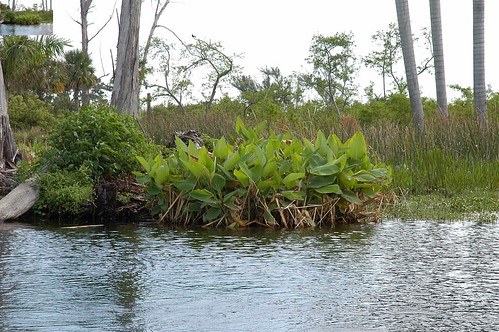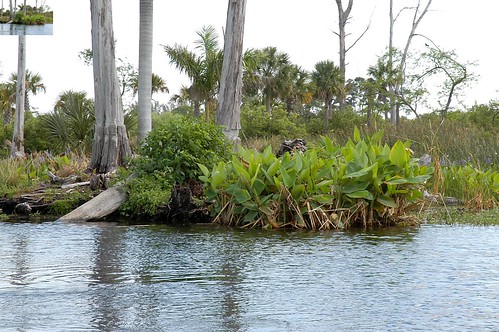A few nice Chain of title images I found:
20100421_Square or “Chain of” Lake (aka: Lake Osborne)

Image by Mberjano
HISTORY OF LAKE OSBORNE
1.1PROJECT NEED OR OPPORTUNITY.
Lake Osborne was part of an extensive system of natural freshwater lakes and marshes extending approximately 30 miles along the western slope of the Atlantic Coastal Ridge in Palm Beach County. Pearce (1970) described Lake Osborne in 1878 as a large freshwater lake 1¾ miles west of Lake Worth (Lake Worth Lagoon) surrounded by a vast swamp with unknown woods to the west. Pearce’s map comparing Lake Osborne of 1883 with 1969 shows these extensive marshes on the western side of the open water (Figure 2). Pearce also refers to the magnitude of these marshes in his description of hunting in and around Lake Osborne. The “Lake Osborne” name is used by Pearce and is also referenced in a July 14, 1894 issue of The Gazetteer. No resource has turned up the source of the name and it is assumed by the State Historian that the name came from an early settler living in the vicinity when a mapping expedition first arrived to map this part of Florida.
The Atlantic Coastal Ridge is a narrow (2 to10 miles wide) limestone ridge that forms a barrier between the ocean and the Everglades basin. Cities originally developed along this high and dry ridge. Early dredging of the lakes and surrounding marshes occurred during construction of the first canal network by the Lake Worth Drainage District and the Army Corps of Engineers in the early 1900s. By draining the swamps, the canals would open Florida’s fertile farming interior to rich markets of the northeastern United States. Much of the wet prairies and marshes around Lake Osborne were lost due to this drainage in order to create farmlands. A map of Lake Osborne’s shoreline completed approximately 3 years after the Lake Worth Drainage District canals were dug shows the project area was still within the historical lake/wetland footprint (Figure __).
Despite this earlier drainage, a 1937 map still shows extensive marshes around Lake Osborne and within the project location (Figure 3). This 1937 map shows the area as it was mapped when John Prince, a County Commissioner, first approached the State government for ownership of the bottomlands for a public park for Palm Beach County. The state agreed to Prince’s request provided he obtained ownership of the adjacent uplands to the west. When approached, the adjacent landowners to the west donated their lands. In 1939
the state passed an act deeding the bottomlands to Palm Beach County, thus creating the second oldest county park in the State of Florida.
The parcels, including Lake Osborne, totaled 1,154 ac. and encompassed land bounded by what is now Lantana Road to the south, Lake Worth Road to the north, Congress Avenue to the west, and Lake Osborne Drive to the east. John Prince’s original plans were to dredge the lake for fill for the shores of the park and for road beds for what is now Lake Osborne Drive (along the eastern shore of Lake Osborne) and for fill to replace the old wooden Lantana Road bridge with a concrete causeway.
The Lake Osborne area was further impacted in the 1940s by more drainage from additional canals that were constructed to expand the original canal network, and Lake Osborne was probably also dredged during this construction. The expanded canal system bisects the lake in several locations. It is likely that filling of the adjacent wetlands for residential construction occurred at the same time or later. The park parcel was nibbled away with the building of an auxiliary military field in 1941, which later became the present day Lantana Airport to the south. Additional acreage (114 ac.) from the northwest corner was donated to the Palm Beach Community College for a permanent location in 1956. Thus, the present-day John Prince Park, which did not receive its name until 1952 after Prince’s death, encompasses 726 acres. Dredging and filling of Lake Osborne to accommodate the initial development of the park and building of Lake Osborne Drive all occurred in the early to mid 1950s. Square Lake and its oxbow were dredged to provide additional fill for the park in the 1960s and early 1970s. As a result, the oxbow is 15 to 20 ft. deep in the center and deep holes are present in the north lobe of Lake Osborne. Square Lake was left as a shallow lake with the water averaging 5 ft. in depth. Picnic tables, hiking/walking trails, and other park amenities surround the north lobe of Lake Osborne, Square Lake and its oxbow. The area designated as Custard Apple Slough had been more or less left in its natural state. There is a walking trail through the north portion of the Slough. The majority of the Slough presently is not accessible for public use. All the park area, with the exception of Custard Apple Slough, had previously been demucked and filled. The campground was also constructed in the 1960s. The last time dredging has occurred in Lake Osborne was in the north lobe in the early 1970s for fill for construction of the nearby segment of Interstate 95.
_____________________________
History of Custard Apple Slough
The Custard Apple Slough was originally open water habitat. When LWDD lowered the water level to 9 feet from 15 feet, aquatic vegetation colonized this area. In the early 1970’s there was still some open water to be seen from the boardwalk observation platform, but most of the slough was mixed cattail and sawgrass. Willow rapidly invaded there areas and became the dominant vegetation by the mid 1980’s. The boardwalk was abandoned when the wood rotted and the willow blocked the view.
Freshwater Lakes in Palm Beach County
Palm Beach County has many freshwater lakes that serve, directly or indirectly, as sources of drinking water, surfacewater storage and recreation. In an effort to better manage and restore the natural resources of the chain-of-lakes system (Lakes Pine, Clarke, Osborne, Eden and Ida) in the eastern part of the County, the County has evaluated the status of its freshwater ecosystems and developed a management plan titled “State of the Lakes” to protect, restore and enhance the natural resource values the lakes provide. (Create at link to Management plan here)
The “flow” within Lake Osborne is determined by the discharge patterns of the South Florida Water Management District’s water control structures which discharge to Lake Worth Lagoon. Lake Osborne is located between the C-51 canal structure to its north and the C-16 structure to the south. The structure which controls the C-51 canal, the largest discharging canal to the Lake Worth Lagoon, can discharge an average of 356 million gallons per day. This structure is located approximately 2 miles north and east of the north lobe of Lake Osborne and appears to be the major influence on the lake’s water movement causing its flow pattern to generally be from south to north.
Originally the project area was part of an extensive wetland/lake system derived from trapped rainwater on the western slope of the Atlantic Coastal Ridge. With acquisition of the land by the Palm Beach County, the project area was earmarked for development as a county park. John Prince Park came into being in the mid 1930s and subsequently the majority of the wetlands were filled with clean filled dredged from Lake Osborne. Some of the remnant wetlands remain, i.e., Custard Apple Slough, but for the most part, the wetlands are gone and the lake shores have long since been demucked and filled. Custard Apple Slough remains but is severely challenged with a multiplicity of exotic vegetation species. The remainder of the Park was developed and landscaped. The 6-acre wetland remains from the original wetland system that is now Picnic Island, Square Lake and its oxbow. Square Lake and its oxbow were dredged from the fill originally placed when the area was demucked. John Prince Park is a popular park with heavy usage by visitors and anglers alike.
20100421_Square or “Chain of” Lake (aka: Lake Osborne)

Image by Mberjano
HISTORY OF LAKE OSBORNE
1.1PROJECT NEED OR OPPORTUNITY.
Lake Osborne was part of an extensive system of natural freshwater lakes and marshes extending approximately 30 miles along the western slope of the Atlantic Coastal Ridge in Palm Beach County. Pearce (1970) described Lake Osborne in 1878 as a large freshwater lake 1¾ miles west of Lake Worth (Lake Worth Lagoon) surrounded by a vast swamp with unknown woods to the west. Pearce’s map comparing Lake Osborne of 1883 with 1969 shows these extensive marshes on the western side of the open water (Figure 2). Pearce also refers to the magnitude of these marshes in his description of hunting in and around Lake Osborne. The “Lake Osborne” name is used by Pearce and is also referenced in a July 14, 1894 issue of The Gazetteer. No resource has turned up the source of the name and it is assumed by the State Historian that the name came from an early settler living in the vicinity when a mapping expedition first arrived to map this part of Florida.
The Atlantic Coastal Ridge is a narrow (2 to10 miles wide) limestone ridge that forms a barrier between the ocean and the Everglades basin. Cities originally developed along this high and dry ridge. Early dredging of the lakes and surrounding marshes occurred during construction of the first canal network by the Lake Worth Drainage District and the Army Corps of Engineers in the early 1900s. By draining the swamps, the canals would open Florida’s fertile farming interior to rich markets of the northeastern United States. Much of the wet prairies and marshes around Lake Osborne were lost due to this drainage in order to create farmlands. A map of Lake Osborne’s shoreline completed approximately 3 years after the Lake Worth Drainage District canals were dug shows the project area was still within the historical lake/wetland footprint (Figure __).
Despite this earlier drainage, a 1937 map still shows extensive marshes around Lake Osborne and within the project location (Figure 3). This 1937 map shows the area as it was mapped when John Prince, a County Commissioner, first approached the State government for ownership of the bottomlands for a public park for Palm Beach County. The state agreed to Prince’s request provided he obtained ownership of the adjacent uplands to the west. When approached, the adjacent landowners to the west donated their lands. In 1939
the state passed an act deeding the bottomlands to Palm Beach County, thus creating the second oldest county park in the State of Florida.
The parcels, including Lake Osborne, totaled 1,154 ac. and encompassed land bounded by what is now Lantana Road to the south, Lake Worth Road to the north, Congress Avenue to the west, and Lake Osborne Drive to the east. John Prince’s original plans were to dredge the lake for fill for the shores of the park and for road beds for what is now Lake Osborne Drive (along the eastern shore of Lake Osborne) and for fill to replace the old wooden Lantana Road bridge with a concrete causeway.
The Lake Osborne area was further impacted in the 1940s by more drainage from additional canals that were constructed to expand the original canal network, and Lake Osborne was probably also dredged during this construction. The expanded canal system bisects the lake in several locations. It is likely that filling of the adjacent wetlands for residential construction occurred at the same time or later. The park parcel was nibbled away with the building of an auxiliary military field in 1941, which later became the present day Lantana Airport to the south. Additional acreage (114 ac.) from the northwest corner was donated to the Palm Beach Community College for a permanent location in 1956. Thus, the present-day John Prince Park, which did not receive its name until 1952 after Prince’s death, encompasses 726 acres. Dredging and filling of Lake Osborne to accommodate the initial development of the park and building of Lake Osborne Drive all occurred in the early to mid 1950s. Square Lake and its oxbow were dredged to provide additional fill for the park in the 1960s and early 1970s. As a result, the oxbow is 15 to 20 ft. deep in the center and deep holes are present in the north lobe of Lake Osborne. Square Lake was left as a shallow lake with the water averaging 5 ft. in depth. Picnic tables, hiking/walking trails, and other park amenities surround the north lobe of Lake Osborne, Square Lake and its oxbow. The area designated as Custard Apple Slough had been more or less left in its natural state. There is a walking trail through the north portion of the Slough. The majority of the Slough presently is not accessible for public use. All the park area, with the exception of Custard Apple Slough, had previously been demucked and filled. The campground was also constructed in the 1960s. The last time dredging has occurred in Lake Osborne was in the north lobe in the early 1970s for fill for construction of the nearby segment of Interstate 95.
_____________________________
History of Custard Apple Slough
The Custard Apple Slough was originally open water habitat. When LWDD lowered the water level to 9 feet from 15 feet, aquatic vegetation colonized this area. In the early 1970’s there was still some open water to be seen from the boardwalk observation platform, but most of the slough was mixed cattail and sawgrass. Willow rapidly invaded there areas and became the dominant vegetation by the mid 1980’s. The boardwalk was abandoned when the wood rotted and the willow blocked the view.
Freshwater Lakes in Palm Beach County
Palm Beach County has many freshwater lakes that serve, directly or indirectly, as sources of drinking water, surfacewater storage and recreation. In an effort to better manage and restore the natural resources of the chain-of-lakes system (Lakes Pine, Clarke, Osborne, Eden and Ida) in the eastern part of the County, the County has evaluated the status of its freshwater ecosystems and developed a management plan titled “State of the Lakes” to protect, restore and enhance the natural resource values the lakes provide. (Create at link to Management plan here)
The “flow” within Lake Osborne is determined by the discharge patterns of the South Florida Water Management District’s water control structures which discharge to Lake Worth Lagoon. Lake Osborne is located between the C-51 canal structure to its north and the C-16 structure to the south. The structure which controls the C-51 canal, the largest discharging canal to the Lake Worth Lagoon, can discharge an average of 356 million gallons per day. This structure is located approximately 2 miles north and east of the north lobe of Lake Osborne and appears to be the major influence on the lake’s water movement causing its flow pattern to generally be from south to north.
Originally the project area was part of an extensive wetland/lake system derived from trapped rainwater on the western slope of the Atlantic Coastal Ridge. With acquisition of the land by the Palm Beach County, the project area was earmarked for development as a county park. John Prince Park came into being in the mid 1930s and subsequently the majority of the wetlands were filled with clean filled dredged from Lake Osborne. Some of the remnant wetlands remain, i.e., Custard Apple Slough, but for the most part, the wetlands are gone and the lake shores have long since been demucked and filled. Custard Apple Slough remains but is severely challenged with a multiplicity of exotic vegetation species. The remainder of the Park was developed and landscaped. The 6-acre wetland remains from the original wetland system that is now Picnic Island, Square Lake and its oxbow. Square Lake and its oxbow were dredged from the fill originally placed when the area was demucked. John Prince Park is a popular park with heavy usage by visitors and anglers alike.
Jerry Cantrell Of Alice In Chains

Image by Metal Chris
Jerry Cantrell playing with Alice In Chains at the 9:30 Club in Washington DC to start their 2009 US tour. Wish I had a better zoom but my little point and shoot can only do so much! Still, I like how it came out anyways. If you want to see any of the 5 videos I shot during this concert, just click the song titles below.
Them Bones / Dam That River
Acid Bubble
Would?
Check My Brain
No Excuses





